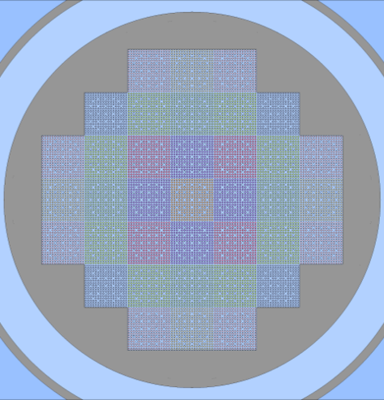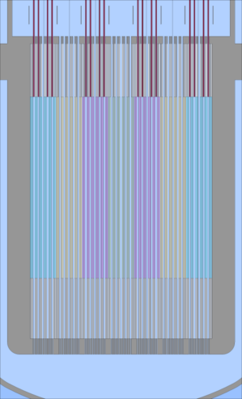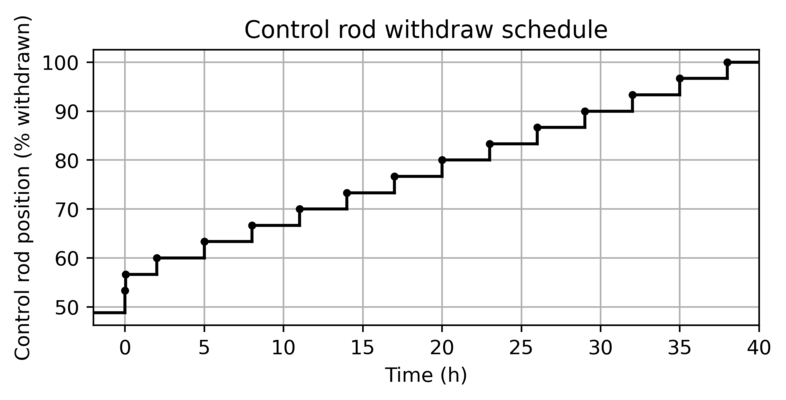SMR startup simulation (outdated)
Contents
Overview
In order to test and demonstrate the time dependent calculation capabilities of the Kraken framework in a reasonably realistic context, a time dependent simulation was conducted of the initial rise to power of a small modular reactor (SMR) core. The simulation used the Ants nodal neutronics code to resolve the evolution of neutronics and the xenon fission poison chain in the system and the SUBCHANFLOW thermal hydraulics code to solve the coolant flow and heat transfer in fuel rods.
The modelled SMR is the same 37 assembly Er-UO2 fuelled core that has been previously used for the demonstration of the depletion capabilities of Kraken:
The transient starts from critical hot zero power (HZP) conditions (actually from 1 % power level) with all control rod banks at approximately 50 % insertion. The boron concentration in the coolant corresponds to the critical boron at all rods out (ARO) hot full power (HFP) conditions. The control rods are withdrawn from the core in a stepwise manner over 38 hours to allow for the accumulation of xenon in the core:
To reformulate the simulation setup:
- Evaluate (in a time-independent simulation) critical boron at hot full power all rods out conditions with convergence in
- Neutronics
- Thermal hydraulics
- Fuel temperature
- Xenon
- Using that critical boron, evaluate (in a time-independent simulation) critical control rod position at 1 % power level with convergence in
- Neutronics
- Thermal hydraulics
- Fuel temperature
- Xenon
- Save initial conditions from the 1 % power level time-independent calculation.
- Start a time dependent simulation from 1 % power level and slowly withdraw the control rods fully from the core.
If the time-independent and time-dependent calculation methodologies produce equivalent steady state solutions and have been correctly implemented, the simulation should (in the end) end up in the same state as the time-independent HFP ARO calculation.
Evaluating HFP ARO critical boron
The first part of the simulation is only needed here in order to obtain a more realistic and reasonable end state for the transient simulation by finding a realistic boron concentration for the coolant. The simulation is set up as a normal coupled steady state simulation between Ants and SUBCHANFLOW with Ants using its equilibrium xenon calculation mode and iterating the coolant boron concentration to reach a critical system. The system power is set to 50 MW, which corresponds to the nominal full power in the Er-UO2 core.
The Cerberus input used for the calculation is included below and is a rather simple coupled calculation input. It may be interesting to note that since Ants is developed in the Kraken context, many of the basic input data can be sent to Ants via Cerberus (control rod positions, system power, xenon calculation mode, iteration mode etc.). The same Ants input is actually used for all of the simulations here with the relevant parts of the Ants model being modified via Cerberus instead of in the Ants input file. Conversely, as SUBCHANFLOW is developed by KIT and the Kraken-coupling is achieved via a VTT written SUBCHANFLOW wrapper the amount of possible input data accessible via Cerberus is more limited and the steady state simulations use a (very slightly) different input file for SUBCHANFLOW than the transient simulation.
Cerberus input for HPF ARO boron iteration
from os import environ
from pathlib import Path
import numpy as np
import cerberus as cb
from cerberus.solvers import CodeInput
from cerberus.solvers import Solver
from cerberus.interpolation import Interpolator
from numpy.core.fromnumeric import size
# Verbosity for terminal output of Cerberus
cb.LOG.set_verbosity(1)
# Create and start solvers
solver_defs = [["SCF", environ["SCFWRAP_EXE_PATH"], [], ["./Inputs/scf/input.txt"]],
["ANTS", environ["ANTS_EXE_PATH"], ["--cerberus","--port"], ["./Inputs/Ants8g.inp"]]]
solvers = {}
port_number = 2211
for name, solver_path, params, inputs in solver_defs:
# Create input
solver_input = CodeInput(name, inputs)
# Create solver
solver = Solver(name, solver_path, params)
solver.input = solver_input
solver.initialize(port_number)
# Add to solver dict
solvers[name] = solver
port_number += 1
# Alias variables for solvers
scf = solvers["SCF"]
ants = solvers["ANTS"]
# Get SCF fields needed for coupled calculation
scf_cool_temperature = scf.get_transferrable("scf_of_cool_temperature_chan")
scf_cool_density = scf.get_transferrable("scf_of_cool_density_chan")
scf_fuel_temperature = scf.get_transferrable("scf_of_fuel_temperature_vol_ave")
scf_power = scf.get_transferrable("scf_if_fuel_power")
# Initialize SCF power field (50 MW divided uniformly over SCF cells)
scf_power.value_vec = 50e6/scf_power.n_values*np.ones(scf_power.n_values)
# Get Ants fields needed for coupled calculation
ants_cool_temperature = ants.get_transferrable("Ants_if_coolant_temperature")
ants_cool_density = ants.get_transferrable("Ants_if_coolant_density")
ants_fuel_temperature = ants.get_transferrable("Ants_if_fuel_temperature")
ants_power = ants.get_transferrable("Ants_of_supernode_power")
ants_boron = ants.get_transferrable("Ants_ov_boron")
# Create interpolators that handle data transfer between SCF and Ants
interp_ct = Interpolator.from_file(scf_cool_temperature,
ants_cool_temperature,
"./Inputs/scf_to_ants.txt")
interp_cd = Interpolator.from_file(scf_cool_density,
ants_cool_density,
"./Inputs/scf_to_ants.txt")
interp_ft = Interpolator.from_file(scf_fuel_temperature,
ants_fuel_temperature,
"./Inputs/scf_to_ants.txt")
interp_p = Interpolator.from_file(ants_power,
scf_power,
"./Inputs/ants_to_scf.txt")
################################################################################
################################################################################
# --- Coupled solution
max_iter = 50
for i in range(max_iter):
# --- TH solution and communication
scf_power.communicate()
scf_power.write_simple(suffix_in=f"{i+1}")
scf.solve()
scf_cool_density.communicate()
scf_cool_temperature.communicate()
scf_fuel_temperature.communicate()
# --- Transfers from SCF to Ants fields
interp_ct.interpolate()
interp_cd.interpolate()
interp_ft.interpolate()
# --- Neutronics solution and communication
ants_cool_density.communicate()
ants_cool_temperature.communicate()
ants_fuel_temperature.communicate()
ants.solve()
ants_power.communicate()
ants_boron.communicate()
# --- Transfers from Ants to SCF
interp_p.interpolate()
print(f"Finished iteration {i+1}, boron is {ants_boron.value_vec[0]}")
# Choose field/value names to save
to_save = ["Ants_ov_keff", "Ants_ov_boron"]
# Output path. Create folder if necessary
output_path = Path(f"./output")
output_path.mkdir(exist_ok=True)
for name in to_save:
tra = ants.get_transferrable(name)
tra.communicate()
tra.write_simple(suffix_in="final", folder_path=output_path)
As we can see from the Cerberus output, the coupled boron iteration convergences in a fast an orderly manner:
Part of Cerberus output for HPF ARO boron iteration
[...] Finished iteration 1, boron is 241.11834260327765 Finished iteration 2, boron is 215.2718468141726 Finished iteration 3, boron is 185.87313896299054 Finished iteration 4, boron is 173.3774955249861 Finished iteration 5, boron is 168.31982440662546 Finished iteration 6, boron is 166.32566143451567 Finished iteration 7, boron is 165.53688601825667 Finished iteration 8, boron is 165.22148909016465 Finished iteration 9, boron is 165.09469219887114 Finished iteration 10, boron is 165.04377146272464 Finished iteration 11, boron is 165.02336734511618 Finished iteration 12, boron is 165.01519526345925 Finished iteration 13, boron is 165.01192023065747 Finished iteration 14, boron is 165.01060719962356 Finished iteration 15, boron is 165.01008083683476 Finished iteration 16, boron is 165.0098698863875 Finished iteration 17, boron is 165.00978535430409 Finished iteration 18, boron is 165.00975148002385 Finished iteration 19, boron is 165.00973790525023 Finished iteration 20, boron is 165.00973246547196 Finished iteration 21, boron is 165.00973028562368 Finished iteration 22, boron is 165.0097294122978 Finished iteration 23, boron is 165.00972906258608 Finished iteration 24, boron is 165.00972892269846 Finished iteration 25, boron is 165.00972886673708 Finished iteration 26, boron is 165.00972884457883 Finished iteration 27, boron is 165.0097288359729 Finished iteration 28, boron is 165.00972883267053 Finished iteration 29, boron is 165.0097288315528 Finished iteration 30, boron is 165.00972883133392 Finished iteration 31, boron is 165.0097288314835 Finished iteration 32, boron is 165.00972883169874 Finished iteration 33, boron is 165.00972883198824 Finished iteration 34, boron is 165.00972883232353 Finished iteration 35, boron is 165.0097288326507 Finished iteration 36, boron is 165.0097288330322 Finished iteration 37, boron is 165.0097288333984 Finished iteration 38, boron is 165.00972883373572 Finished iteration 39, boron is 165.00972883417126 Finished iteration 40, boron is 165.0097288345529 Finished iteration 41, boron is 165.00972883480839 Finished iteration 42, boron is 165.00972883514726 Finished iteration 43, boron is 165.00972883548843 Finished iteration 44, boron is 165.00972883586263 Finished iteration 45, boron is 165.0097288362657 Finished iteration 46, boron is 165.00972883654 Finished iteration 47, boron is 165.0097288368571 Finished iteration 48, boron is 165.00972883725518 Finished iteration 49, boron is 165.009728837629 Finished iteration 50, boron is 165.00972883798943
Evaluating critical control rod position at HZP fixed boron conditions
Cerberus input for HZP control rod iteration
Part of Cerberus output for HZP control rod iteration
[...] Height is 150.0, keff is 1.0137994157229595 (based on 3 coupled iterations) Height is 140.0, keff is 1.0097132150307848 (based on 3 coupled iterations) Height is 130.0, keff is 1.004371680638068 (based on 3 coupled iterations) Height is 120.0, keff is 0.9974297441040372 (based on 3 coupled iterations) Height is 121.0, keff is 0.997992947986957 (based on 6 coupled iterations) Height is 122.0, keff is 0.9986113787463294 (based on 6 coupled iterations) Height is 123.0, keff is 0.999327881570897 (based on 6 coupled iterations) Height is 124.0, keff is 1.000166398442108 (based on 6 coupled iterations) Height is 123.9, keff is 1.0000762007919366 (based on 9 coupled iterations) Height is 123.80000000000001, keff is 0.9999875162017355 (based on 9 coupled iterations) Height is 123.81000000000002, keff is 0.9999963183709505 (based on 12 coupled iterations) Height is 123.82000000000002, keff is 1.00000513516873 (based on 12 coupled iterations) Height is 123.81900000000002, keff is 1.0000042528284148 (based on 15 coupled iterations) Height is 123.81800000000001, keff is 1.000003370634821 (based on 15 coupled iterations) Height is 123.81700000000001, keff is 1.0000024885879013 (based on 15 coupled iterations) Height is 123.816, keff is 1.0000016066876227 (based on 15 coupled iterations) Height is 123.815, keff is 1.0000007249339529 (based on 15 coupled iterations) Height is 123.814, keff is 0.9999998433268541 (based on 15 coupled iterations) Height is 123.8141, keff is 0.9999999314800674 (based on 18 coupled iterations)
Saving initial conditions for the transient
Cerberus input for the transient simulation


